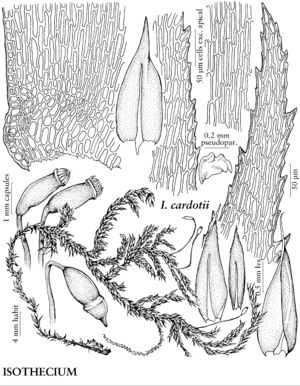Difference between revisions of "Isothecium cardotii"
Bull. Torrey Bot. Club 17: 278. 1890.
FNA>Volume Importer |
imported>Volume Importer |
||
| (6 intermediate revisions by 2 users not shown) | |||
| Line 12: | Line 12: | ||
}}{{Treatment/ID/Special_status | }}{{Treatment/ID/Special_status | ||
|code=F | |code=F | ||
| − | |label= | + | |label=Illustrated |
}} | }} | ||
|basionyms= | |basionyms= | ||
| Line 29: | Line 29: | ||
|elevation=low to moderate elevations | |elevation=low to moderate elevations | ||
|distribution=B.C.;Alaska;Oreg.;Wash. | |distribution=B.C.;Alaska;Oreg.;Wash. | ||
| − | |discussion=<p>Isothecium cardotii is clearly related to I. stoloniferum and can grow with it, but is readily separated in size alone in most specimens. Occasionally, specimens of I. stoloniferum are of similar size, but the presence of flagelliform branches identifies I. stoloniferum. The primary stem leaves are often unpigmented, abruptly narrowed and small; the branchlet leaf costae are broad at the base and tapering toward the apex.</p> | + | |discussion=<p><i>Isothecium cardotii</i> is clearly related to <i>I. stoloniferum</i> and can grow with it, but is readily separated in size alone in most specimens. Occasionally, specimens of <i>I. stoloniferum</i> are of similar size, but the presence of flagelliform branches identifies <i>I. stoloniferum</i>. The primary stem leaves are often unpigmented, abruptly narrowed and small; the branchlet leaf costae are broad at the base and tapering toward the apex.</p> |
|tables= | |tables= | ||
|references= | |references= | ||
| Line 38: | Line 38: | ||
-->{{#Taxon: | -->{{#Taxon: | ||
name=Isothecium cardotii | name=Isothecium cardotii | ||
| − | |||
|authority=Kindberg | |authority=Kindberg | ||
|rank=species | |rank=species | ||
| Line 51: | Line 50: | ||
|publication title=Bull. Torrey Bot. Club | |publication title=Bull. Torrey Bot. Club | ||
|publication year=1890 | |publication year=1890 | ||
| − | |special status=Endemic; | + | |special status=Endemic;Illustrated |
| − | |source xml=https:// | + | |source xml=https://bitbucket.org/aafc-mbb/fna-data-curation/src/2e0870ddd59836b60bcf96646a41e87ea5a5943a/coarse_grained_fna_xml/V28/V28_973.xml |
|genus=Isothecium | |genus=Isothecium | ||
|species=Isothecium cardotii | |species=Isothecium cardotii | ||
Latest revision as of 22:39, 5 November 2020
Plants large, dark green or yellow to golden green, slightly glossy. Stems with stipe present, secondary stems 3–15 cm, not julaceous, pinnate and frondlike or irregularly branched and somewhat dendroid, branches arching downward when dry, flagelliform branches rare, irregularly branched; pseudoparaphyllia broadly foliose, blunt or with few short teeth. Primary stem leaves broadly to narrowly triangular; margins entire to weakly toothed at apex; apex attenuate, sometimes falcate; ecostate or costa present; alar cells differentiated, region small, to 1/10 leaf length. Branchlet leaves ovate-lanceolate; margins nearly entire to weakly toothed basally, coarsely toothed distally; costa to 2/3 leaf length, occasionally weakly 2-fid, sometimes ending in abaxial spine; alar cells truncate, rectangular, shorter, region well defined, sometimes excavate, extending 1/3 distance across base, less than 1/10 leaf length. Seta 1–2 cm. Capsule 1.5–2 mm.
Habitat: Tree trunks, rocky cliffs, boulders
Elevation: low to moderate elevations
Distribution

B.C., Alaska, Oreg., Wash.
Discussion
Isothecium cardotii is clearly related to I. stoloniferum and can grow with it, but is readily separated in size alone in most specimens. Occasionally, specimens of I. stoloniferum are of similar size, but the presence of flagelliform branches identifies I. stoloniferum. The primary stem leaves are often unpigmented, abruptly narrowed and small; the branchlet leaf costae are broad at the base and tapering toward the apex.
Selected References
None.
